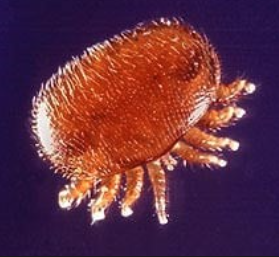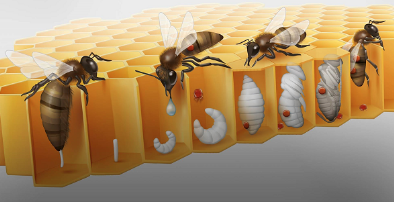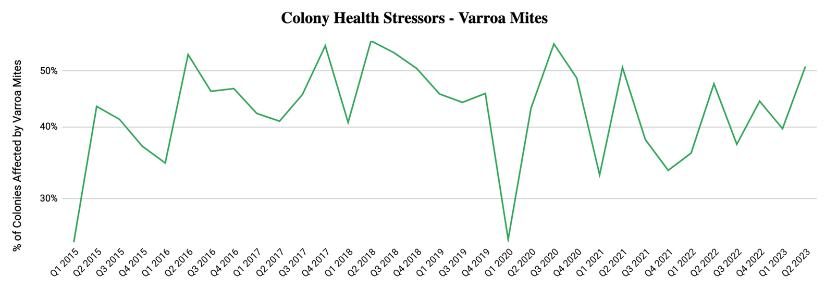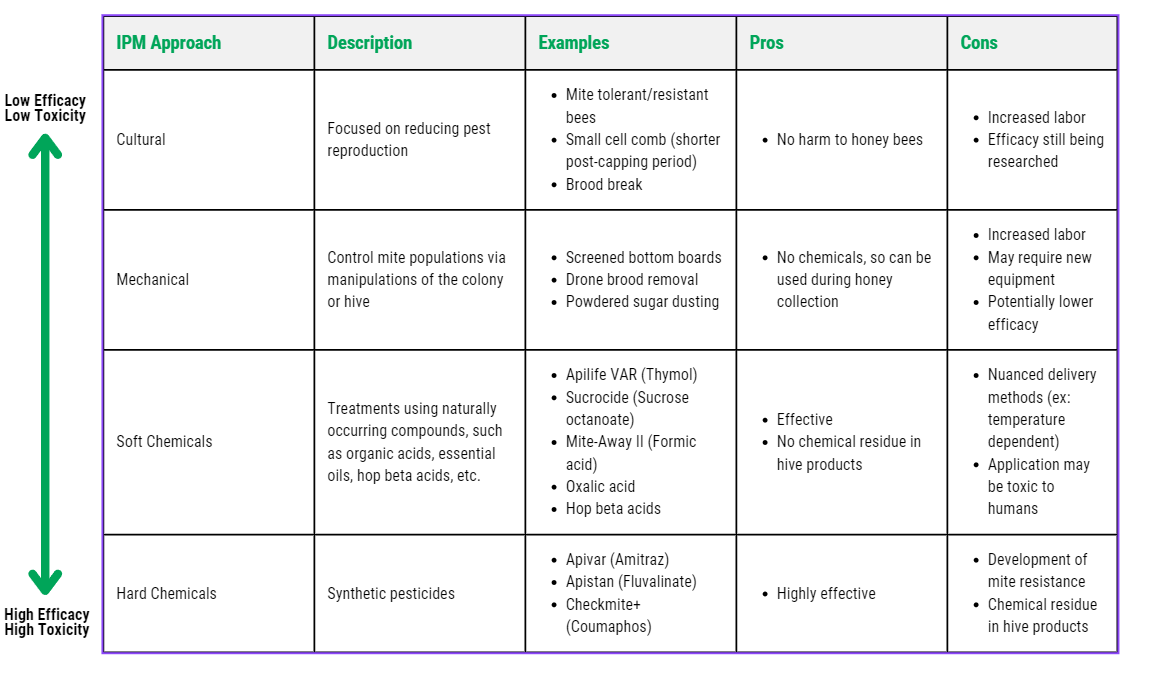

Wouldn’t we do anything to protect our innocent children from harmful, toxic prey? Now imagine those children are the larvae of honey bees - one of the most crucial components of the world’s food supply chain. Varroa mites, a parasitic mite, are doing just this by feeding on the larvae and pupae, as well as full-grown adults, in a developing bee brood. They have quickly risen to be the #1 reason for the decline in the honey bee population and eventual colony breakdown and collapse and we have no effective and sustainable solutions to target Varroa mites - until now.
What are Varroa Mites?
Varroa mites are tiny red-brown parasites that attack and feed on honey bees and are the leading cause of honey bee colony death. These mites act like ticks and attach onto honey bees and feed off the bees’ equivalent of blood (hemolymph fluid). They also act like mosquitos in effectively transmitting an array of pathogenic viruses to honey bees.
Mites ride on adult honey bees, often going undetected by latching on between segments of the honey bee’s abdomen or thorax, as they prey on these adult honey bees’ blood. This stage allows mites to transmit various diseases, as they change hosts often, and rapidly spread to more areas and invade more hives, due to the drifting habits of honey bees. In their reproductive stage, mites exponentially increase their population by invading honey bee larvae and maturing with the drone broods.
Due to the Varroa mite’s wide-reaching impact and ability to grow exponentially, the damaging effect of Varroa mites can be extremely devastating.
Symptoms of a Varroa Mite Infestation
Colonies infested with Varroa mites may display these common signs:
- Weak and short-lived adult bees resulting in diminishing adult population
- Deformed Wing Virus - adult bees with deformed wings may result in impaired flight performance and a lower rate of return to the colony after foraging
- Chewed Down Brood - if bees sense mites in the brood, pupae will be uncapped and cannibalized prematurely
- Malformed brood with missing wings or legs
- Parasitic Mite Syndrome - spotty brood pattern with larvae that appear sunken to the side of the cell
- Mites seen crawling across sealed brood, open brood cells, and/or honey bees
Deadly Spread of Varroa Mites
Varroa mites were first detected in the United States in 1987 and now impact honey bee populations nationwide. The population of honey bees in the United States has dropped alarmingly and unfortunately Varroa mites are the leading culprit for this change. Virtually all feral, or wild, honey bee colonies have been wiped out by Varroa mites. As seen in Figure 1 below, the accelerated decrease in managed commercial honey bee colonies coincides with the introduction of Varroa mites in the 1980s.
Since the United States Department of Agriculture began providing annual reports on honey bee colonies in 2015, Varroa mites have consistently been the top colony stressor for honey bee colonies. As shown in Figure 2 below, the average percentage of commercial honey bee colonies affected by Varroa mites is 43% since 2015. These metrics are only reported for operations with five or more colonies, but it is understood anecdotally that the devastating effect of Varroa mites on colonies are even more pronounced for non-commercial beekeepers. Some experts believe that nearly all managed honey bee colonies have some degree of Varroa mite infestation that may go undetected and underreported.
 Figure 3: Commercial honey bee colonies have decreased more than 13% from 1987 to 2023. SOurce: National Agricultural Statistics Service
Figure 3: Commercial honey bee colonies have decreased more than 13% from 1987 to 2023. SOurce: National Agricultural Statistics Service
 Figure 4: Despite fluctutations due to seasonality of honey bee brooding, Varroa mites have impacted, on average, more than 40% of commercial honey bee colonies since 2015. Source: Honey Bee Colonies report from the United States Department of Agriculture.
Figure 4: Despite fluctutations due to seasonality of honey bee brooding, Varroa mites have impacted, on average, more than 40% of commercial honey bee colonies since 2015. Source: Honey Bee Colonies report from the United States Department of Agriculture.
Existing Integrated Pest Management Practices for Varroa Mites
Below are different integrated pest management ("IPM") practices currently available for Varroa mites:

While there may be a wide range of available Varroa mite treatments, beekeepers must use an IPM approach in which several different techniques are used in combination or in rotation throughout the year to effectively control Varroa mites and avoid resistivity.
Terra Vera - A New Safe, Sustainable, and Effective Way to Treat Varroa Mites
Most treatments are focused on managing and controlling Varroa mite infestation, but no “magic bullet” has been found for Varroa mites. Terra Vera’s proprietary technology has demonstrated efficacy in lysing the cell membrane of soft-bodied pests, which makes it the perfect solution for targeting soft-bodied pests like Varroa mites. Together with Terra Vera’s other unique properties in promoting increased nutrient uptake and enhancing immunity to protect against diseases and pathogens, we are currently developing an integrated system for bee hives that may not only control Varroa mite infestations, but also prevent future mite infestations and provide nutritional supplements to bees. And as with all of our technology, it is gentle on living tissue and biodegradable to inert compounds, which means it is safe for beekeepers, bees, and the planet. In a world where honey bees protect our food sources by pollinating 75% of the world’s crops, Terra Vera hopes to return the favor by protecting the world’s honey bees from their top threat.
Grow Smart from the Start
Using Terra Vera's crop and colony protection and nutrient solutions from start to finish increases bee colony’s ability to fight off environmental stressors. Terra Vera contains no harsh chemicals and is committed to creating a safer, more sustainable future. Terra Vera is looking for partners in the beekeeping industry to help us learn more about the benefits of our revolutionary system to help prevent colony collapse and the use of harsh chemicals in our pesticides.
Are you interested in becoming a research partner?